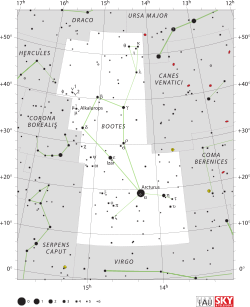CEERS-93316
| CEERS-93316 | |
|---|---|
Location of the CEERS-93316 galaxy is in the upper just right-of-center area of the Boötes constellation. | |
| Observation data (J2000 epoch) | |
| Constellation | Boötes[1][2]/Ursa Major |
| Right ascension | 14h 19m 39.48s[1] |
| Declination | 52° 56′ 34.92″[1] |
| Redshift | 4.912±0.001[3] |
| Distance |
|
| Other designations | |
| CR2-z16-1[5] | |
CEERS-93316 is a high-redshift galaxy with a spectroscopic redshift z=4.9. [3] Significantly, the redshift that was initially reported was photometric (z = 16.4) and would have made CEERS-93316 the earliest and most distant known galaxy observed.[1][6][7][8]
CEERS-93316 has a light-travel distance (lookback time) of 12.6 billion years, and, due to the expansion of the universe, a present proper distance of 25.7 billion light-years.[4]
Discovery[edit]
The candidate high-redshift galaxy CEERS-93316 (RA:14:19:39.48 DEC:+52:56:34.92), in the Boötes constellation,[1][2] was discovered by the CEERS imaging observing program using the Near Infrared Camera of the James Webb Space Telescope (JWST) in July 2022.[1][6][7][8] CEERS stands for "Cosmic Evolution Early Release Science Survey", and is a deep- and wide-field sky survey program developed specifically for JWST image studies, and is conducted by the CEERS Collaboration.[7][8][9]
See also[edit]
References[edit]
- ^ a b c d e f g Donnan, C. T.; et al. (November 2022). "The evolution of the galaxy UV luminosity function at redshifts z ≃ 8 - 15 from deep JWST and ground-based near-infrared imaging". Monthly Notices of the Royal Astronomical Society. 518 (4): 6011–6040. arXiv:2207.12356. Bibcode:2023MNRAS.518.6011D. doi:10.1093/mnras/stac3472.
- ^ a b Staff (2008). "Finding the constellation which contains given sky coordinates". DJM.cc. Retrieved 4 August 2022.
- ^ a b Haro, Pablo Arrabal (2023). "Confirmation and refutation of very luminous galaxies in the early Universe". Nature. 622 (7984): 707–711. arXiv:2303.15431. Bibcode:2023Natur.622..707A. doi:10.1038/s41586-023-06521-7. PMID 37579792. S2CID 257766818.
- ^ a b c Wright, Edward L. (2022). "Ned Wright's Javascript Cosmolgy Calculator". University of California, Los Angeles. Retrieved 17 April 2023. (H0=67.4 and OmegaM=0.315 (see Table/Planck2018 at "Lambda-CDM model#Parameters" )
- ^ Harikane, Yuichi; et al. (2023). "A Comprehensive Study of Galaxies at z ~ 9–16 Found in the Early JWST Data: Ultraviolet Luminosity Functions and Cosmic Star Formation History at the Pre-reionization Epoch". The Astrophysical Journal Supplement Series. 265 (1): 5. arXiv:2208.01612. Bibcode:2023ApJS..265....5H. doi:10.3847/1538-4365/acaaa9. S2CID 251253150.
- ^ a b Amos, Jonathan (26 July 2022). "Scottish astronomers push James Webb deeper back in time". BBC News. Retrieved 4 August 2022.
- ^ a b c Tognetti, Laurence (2 August 2022). "The record for the farthest galaxy was just broken again, now just 250 million years after the Big Bang". Universe Today. Retrieved 3 August 2022.
- ^ a b c Turner, Ben (1 August 2022). "Webb space telescope has just imaged another most-distant galaxy, breaking its record after a week". Live Science. Retrieved 3 August 2022.
- ^ Clery, Daniel (9 August 2022). "Webb telescope reveals unpredicted bounty of bright galaxies in early universe - Star formation after the big bang appears much faster than models had forecast". Science. doi:10.1126/science.ade3381. Retrieved 11 August 2022.





